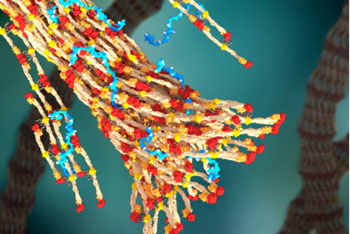Injectable Polymer Helps Impede Severe Bleeding
By HospiMedica International staff writers
Posted on 26 Mar 2015
A new polymer helps develop a solid blood clot by fusing fibrin strands to each other, creating an interlinked web capable of withstanding pressure.Posted on 26 Mar 2015
Developed by researchers at the University of Washington (Seattle, WA, USA), PolySTAT induces hemostasis by cross-linking the fibrin matrix within clots, mimicking the function of transglutaminase clotting factor XIII (fibrin stabilizing factor). The synthetic polymer circulates innocuously in the blood, identifies sites of vascular injury, and then promotes clot formation by binding specifically to fibrin monomers during polymerization, resulting in a fortified, hybrid polymer blood clot with enhanced resistance to enzymatic degradation.

Image: Fibrin forming a blood clot, with PolySTAT (in blue) binding strands together (Photo courtesy of William Walker/University of Washington).
The synthetic polymer also offers other advantages over conventional hemorrhaging treatments, as natural blood products are expensive, need careful storage, and can harbor bacteria or infectious diseases. PolySTAT can also strengthen clots even in cases where fibrin building blocks are critically low. It also uses a highly specific peptide that only binds to fibrin at the wound site, and does not bind to fibrin a precursors that circulate throughout the body, which could potentially lead to dangerous thrombi that can cause stroke or embolism.
In vivo hemostatic activity was confirmed in a rat model of trauma to the femoral artery and subsequent intravenous (IV) fluid resuscitation, in which intravenous administration of PolySTAT improved survival by reducing blood loss and fluid requirements. The researchers showed a 100% success rate in stopping bleeding to the otherwise lethal injury; for comparison, rats that were treated with albumin had only a 20% survival rate. The study describing the novel polymer was published in the March 4, 2015, issue of Science Translational Medicine.
“Most of the patients who die from bleeding die quickly,” said coauthor Assistant Professor of Emergency Medicine Nathan White, MD. “This is something you could potentially put in a syringe inside a backpack and give right away to reduce blood loss and keep people alive long enough to make it to medical care.”
Related Links:
University of Washington














